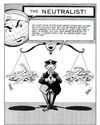Intentar ORO - Gratis
We Could Have Had Cellphones Four Decades Earlier
Reason magazine
|July 2017
Thanks for nothing, Federal Communications Commission.

The basic idea of the cellphone was introduced to the public in 1945—not in Popular Mechanics or Science, but in the downhome Saturday Evening Post. Millions of citizens would soon be using “handie-talkies,” declared J.K. Jett, the head of the Federal Communications Commission (fcc). Licenses would have to be issued, but that process “won’t be difficult.” The revolutionary technology, Jett promised in the story, would be formulated within months.But permission to deploy it would not. The government would not allocate spectrum to realize the engineers’ vision of “cellular radio” until 1982, and licenses authorizing the service would not be fully distributed for another seven years. That’s one heck of a bureaucratic delay.
PRIMITIVE PHONES AND SPECTRUM-HOARDING
BEFORE THERE WERE cellphones, there was the mobile telephone service, or mts. Launched in 1946, this technology required unwieldy and expensive equipment—the transceiver could fill the trunk of a sedan—and its networks faced tight capacity constraints. In the beginning, the largest mts markets had no more than 44 channels. As late as 1976, Bell System’s mobile network in New York could host just 545 subscribers. Even at sky-high prices, there were long waiting lists for subscriptions.
Cellular networks were an ingenious way to expand service dramatically. A given market would be split into cells with a base station in each. These stations, often located on towers to improve line-of-sight with mobile phone users, were able both to receive wireless signals and to transmit them. The base stations were themselves linked together, generally by wires, and connected to networks delivering plain old telephone service.
Esta historia es de la edición July 2017 de Reason magazine.
Suscríbete a Magzter GOLD para acceder a miles de historias premium seleccionadas y a más de 9000 revistas y periódicos.
¿Ya eres suscriptor? Iniciar sesión
MÁS HISTORIAS DE Reason magazine

Reason magazine
A Nostalgic Read for Foreign Policy Elites
IF YOU WERE looking for a human avatar of America's unipolar moment, you couldn't do better than Michael McFaul. Picture a youthful, energetic McFaul with a newly minted Ph.D. bounding into the suddenly post-Soviet space of the early 1990s, full of bright ideas about democracy and faith in the end of history. As McFaul himself puts it, 1991 \"was a glorious moment to be a democratic, liberal, capitalist, multilateralist, and American....I was treated like a rockstar.\"
4 mins
January 2026

Reason magazine
TRUMP IS DEPORTING ENTREPRENEURS
THE TRUMP ADMINISTRATION'S MASS DEPORTATION EFFORT IS ROBBING THE U.S. OF IMMIGRANT BUSINESS OWNERS AND THEIR CONTRIBUTIONS.
9 mins
January 2026
Reason magazine
The First Information Revolution
PRINTING PRESSES AND LIBRARIANS INTERPRETED CENSORSHIP AS DAMAGE AND ROUTED AROUND IT.
11 mins
January 2026

Reason magazine
What Would Bill Buckley Do?
THE NATIONAL REVIEW FOUNDER'S FLEXIBLE APPROACH TO POLITICS DEFINED CONSERVATISM AS WE KNOW IT.
7 mins
January 2026

Reason magazine
MAHA Mandates Food Labels
BURDENSOME FOOD LABELING mandates were once the province of Democrats, who pushed for calorie count requirements on restaurant menus and insisted packaged food must feature warnings about genet- ically modified ingredients and trans fats. Now it's Republicans leading the charge- with equally foolish results.
2 mins
January 2026

Reason magazine
IS JAKE TAPPER DOOMED?
THE CNN ANCHOR ON THE WAR ON TERROR, THREATS TO FREE SPEECH, AND THE FUTURE OF MEDIA
14 mins
January 2026

Reason magazine
REPUBLICAN SOCIALISM
THE TRUMP ADMINISTRATION IS BUYING STAKES IN COMPANIES. THAT NEVER ENDS WELL.
13 mins
January 2026

Reason magazine
A Taste of Capitalism in Warsaw
WARSAW, POLAND, IS a living museum of economic systems. It's a city where concrete reliefs of stoic factory workers decorate a building that now houses a Kentucky Fried Chicken, where a Soviet-era apartment block stands beside a glass tower filled with coworking spaces.
2 mins
January 2026

Reason magazine
Robert Crumb's Roving Art and Life
IN THE SPRING of 1962, an 18-year-old Robert Crumb was beaned in the forehead by a solid glass ashtray. His mother, Bea, had hurled it at his father, Chuck, who ducked. Robert was bloodied and dazed, once again a silent and enraged witness to his family's chaos.”
5 mins
January 2026

Reason magazine
THE HOWARD ROARK OF COMICS
SPIDER-MAN CO-CREATOR STEVE DITKO WAS A GREAT EXAMPLE OF, AND DIRE WARNING TO, OBJECTIVIST POP ARTISTS.
12 mins
January 2026
Translate
Change font size

